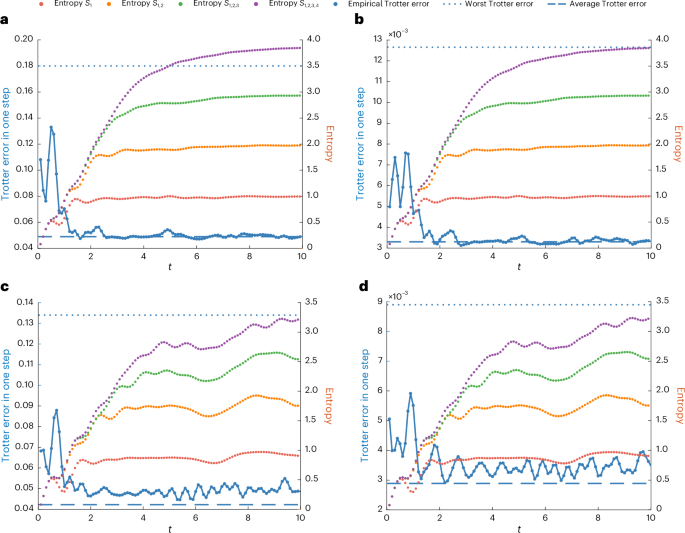Amico, L., Fazio, R., Osterloh, A. & Vedral, V. Entanglement in many-body systems. Rev. Mod. Phys. 80, 517–576 (2008).
Horodecki, R., Horodecki, P., Horodecki, M. & Horodecki, K. Quantum entanglement. Rev. Mod. Phys. 81, 865–942 (2009).
Walter, M., Gross, D. & Eisert, J. in Quantum Information: From Foundations to Quantum Technology Applications (eds Bruss, D. & Leuchs, G.) 293–330 (Wiley, 2016).
Zeng, B., Chen, X., Zhou, D.-L. & Wen, X.-G. Quantum Information Meets Quantum Matter: From Quantum Entanglement to Topological Phases in Many-body Systems (Springer, 2019).
Qi, X.-L. Does gravity come from quantum information? Nat. Phys. 14, 984–987 (2018).
Vidal, G. Efficient classical simulation of slightly entangled quantum computations. Phys. Rev. Lett. 91, 147902 (2003).
Datta, A., Shaji, A. & Caves, C. M. Quantum discord and the power of one qubit. Phys. Rev. Lett. 100, 050502 (2008).
D’Alessio, L., Kafri, Y., Polkovnikov, A. & Rigol, M. From quantum chaos and eigenstate thermalization to statistical mechanics and thermodynamics. Adv. Phys. 65, 239–362 (2016).
Gogolin, C. & Eisert, J. Equilibration, thermalisation, and the emergence of statistical mechanics in closed quantum systems. Rep. Progr. Phys. 79, 056001 (2016).
Nandkishore, R. & Huse, D. A. Many-body localization and thermalization in quantum statistical mechanics. Annu. Rev. Condens. Matter Phys. 6, 15–38 (2015).
Serbyn, M., Abanin, D. A. & Papić, Z. Quantum many-body scars and weak breaking of ergodicity. Nat. Phys. 17, 675–685 (2021).
Cirac, J. I., Perez-Garcia, D., Schuch, N. & Verstraete, F. Matrix product states and projected entangled pair states: concepts, symmetries, theorems. Rev. Mod. Phys. 93, 045003 (2021).
Orús, R. Tensor networks for complex quantum systems. Nat. Rev. Phys. 1, 538–550 (2019).
Altman, E. et al. Quantum simulators: architectures and opportunities. PRX Quantum 2, 017003 (2021).
Lloyd, S. Universal quantum simulators. Science 273, 1073–1078 (1996).
Berry, D. W., Ahokas, G., Cleve, R. & Sanders, B. C. Efficient quantum algorithms for simulating sparse Hamiltonians. Commun. Math. Phys. 270, 359–371 (2007).
Berry, D. W. & Childs, A. M. Black-box Hamiltonian simulation and unitary implementation. Quantum Inf. Comput. 12, 29–62 (2012).
Berry, D. W., Childs, A. M., Cleve, R., Kothari, R. & Somma, R. D. Simulating Hamiltonian dynamics with a truncated Taylor series. Phys. Rev. Lett. 114, 090502 (2015).
Low, G. H. & Chuang, I. L. Optimal Hamiltonian simulation by quantum signal processing. Phys. Rev. Lett. 118, 010501 (2017).
Low, G. H. & Chuang, I. L. Hamiltonian simulation by qubitization. Quantum 3, 163 (2019).
Childs, A. M. & Su, Y. Nearly optimal lattice simulation by product formulas. Phys. Rev. Lett. 123, 050503 (2019).
Childs, A. M., Maslov, D., Nam, Y., Ross, N. J. & Su, Y. Toward the first quantum simulation with quantum speedup. Proc. Natl Acad. Sci. USA 115, 9456–9461 (2018).
Childs, A. M., Su, Y., Tran, M. C., Wiebe, N. & Zhu, S. Theory of Trotter error with commutator scaling. Phys. Rev. X 11, 011020 (2021).
Şahinoğlu, B. & Somma, R. D. Hamiltonian simulation in the low-energy subspace. npj Quantum Inf. 7, 119 (2021).
An, D., Fang, D. & Lin, L. Time-dependent unbounded Hamiltonian simulation with vector norm scaling. Quantum 5, 459 (2021).
Zhao, Q., Zhou, Y., Shaw, A. F., Li, T. & Childs, A. M. Hamiltonian simulation with random inputs. Phys. Rev. Lett. 129, 270502 (2022).
Chen, C.-F. & Brandão, F. G. Average-case speedup for product formulas. Commun. Math. Phys. 405, 32 (2024).
Su, Y., Huang, H.-Y. & Campbell, E. T. Nearly tight Trotterization of interacting electrons. Quantum 5, 495 (2021).
Scott, A. J. Multipartite entanglement, quantum-error-correcting codes, and entangling power of quantum evolutions. Phys. Rev. A 69, 052330 (2004).
Hayden, P., Leung, D. W. & Winter, A. Aspects of generic entanglement. Commun. Math. Phys. 265, 95–117 (2006).
Suzuki, M. General theory of fractal path integrals with applications to many-body theories and statistical physics. J. Math. Phys. 32, 400–407 (1991).
Tran, M. C., Chu, S.-K., Su, Y., Childs, A. M. & Gorshkov, A. V. Destructive error interference in product-formula lattice simulation. Phys. Rev. Lett. 124, 220502 (2020).
Layden, D. First-order Trotter error from a second-order perspective. Phys. Rev. Lett. 128, 210501 (2022).
Kim, H., Ikeda, T. N. & Huse, D. A. Testing whether all eigenstates obey the eigenstate thermalization hypothesis. Phys. Rev. E 90, 052105 (2014).
Shi, F., Li, M.-S., Chen, L. & Zhang, X. k-uniform quantum information masking. Phys. Rev. A 104, 032601 (2021).
Paeckel, S. et al. Time-evolution methods for matrix-product states. Ann. Phys. 411, 167998 (2019).
Bravyi, S., Hastings, M. B. & Verstraete, F. Lieb-Robinson bounds and the generation of correlations and topological quantum order. Phys. Rev. Lett. 97, 050401 (2006).
Chen, B., Xu, J., Zhao, Q. & Yuan, X. Error interference in quantum simulation. Preprint at https://arxiv.org/abs/2411.03255 (2024).
Aaronson, S. Shadow tomography of quantum states. SIAM J. Comput. 49, STOC18-368 (2019).
Huang, H.-Y., Kueng, R. & Preskill, J. Predicting many properties of a quantum system from very few measurements. Nat. Phys. 16, 1050–1057 (2020).
Zhou, Y. & Liu, Q. Performance analysis of multi-shot shadow estimation. Quantum 7, 1044 (2023).
Kovalsky, L. K. et al. Self-healing of Trotter error in digital adiabatic state preparation. Phys. Rev. Lett. 131, 060602 (2023).
Yi, C. & Crosson, E. Spectral analysis of product formulas for quantum simulation. npj Quantum Inf 8, 37 (2022).
Bravyi, S. Monte Carlo simulation of stoquastic Hamiltonians. Quantum Inf. Comput. 15, 1122–1140 (2015).
Bravyi, S. & Gosset, D. Polynomial-time classical simulation of quantum ferromagnets. Phys. Rev. Lett. 119, 100503 (2017).
Motta, M. et al. Determining eigenstates and thermal states on a quantum computer using quantum imaginary time evolution. Nat. Phys. 16, 205–210 (2020).
Howard, M., Wallman, J., Veitch, V. & Emerson, J. Contextuality supplies the ‘magic’ for quantum computation. Nature 510, 351–355 (2014).
Streltsov, A., Adesso, G. & Plenio, M. B. Colloquium: quantum coherence as a resource. Rev. Mod. Phys. 89, 041003 (2017).
Cotler, J. S. et al. Emergent quantum state designs from individual many-body wavefunctions. PRX Quantum 4, 010311 (2023).
Huang, H.-Y., Kueng, R., Torlai, G., Albert, V. V. & Preskill, J. Provably efficient machine learning for quantum many-body problems. Science 377, eabk3333 (2022).

